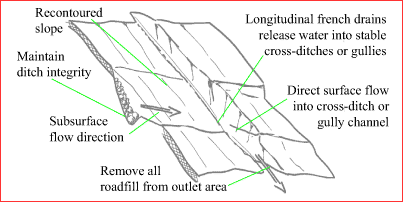|
Forest Road Deactivation Practices
|
|
in the Pacific Northwest
|


|
|
| 15 - French Drains
|
Description, Expectations |
Description
A french drain is a subsurface drainage structure installed to diffuse
heavy seepage or ground water piping which may be encountered during road construction or deactivation. Use french drains where crossditch installation is impractical because:
- the seepage zone is extensive in length,
- the retrieved fill material may be impermeable, and when placed against the cut, would block natural drainage patterns,
- the stability of the recontoured fillslope may be in question.
Figure 11: French Drain Across Grade (carries flows across road)

Expectations
- Material in the french drain should consist of cobbles and boulders from the surrounding road fill.
- The width and height of the french drain depends on the width the seepage zone but should be at least 3 meters (10 feet).
- The french drain extends down the cutslope and across the road bench to the toe of the pulled back road fill.
- The drain outfall should have a rock apron to disperse any flows.
- Never direct water onto unstable slopes/ unprotected erodible soil.
- Remove all potentially unstable material downslope from the french drain outlet.
Longitudinal french drains can be used in cases where bank sloughing
and slide debris will interfere with water flows in an open ditch. They
are used primarily in applications to route surface flows along the
road in order to avoid saturating unstable slopes below the road.
Figure 12: Longitudinal French Drain (carries flows along road)

Blanket drains, french drains, and trench drains are all
very useful in steep ground to prevent water accumulations from intercepted flows, and to maintain the natural micro-drainage of the slope.
|
|
 15 French Drains 15 French Drains
|
©1999 - 2002 Flip Productions Limited
Used with permission by CulvertBC
|

